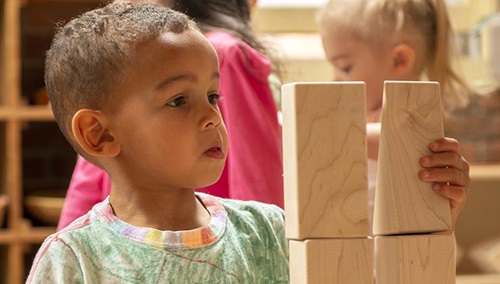The Role of Risk in Play and Learning
| August 2013 
Real play means taking risks—physical, social, and even cognitive. Children are constantly trying out new things and learning a great deal in the process. They love to move from adventure to adventure. They face the risk of mistakes and even of injuries, but that does not deter children. They embrace life, play, and risk with gusto, and they are prepared for a certain amount of bumps and bruises while growing up. Even a broken bone doesn't slow them down for long. Fortunately, they heal fast.
Although no one wants to see a child injured, creating an environment that is overly safe creates a different kind of danger for them. Growing up in a risk-averse society, such as we currently have, means children are not able to practice risk-assessment which enables them to match their skills with the demands of the environment. As a result, many children have become very timid and are reluctant to take risks. At the opposite extreme, many have difficulty reading the situations they face and take foolhardy risks, repeatedly landing in trouble.
Appropriate Risk
When children are given a chance to engage freely in adventurous play they quickly learn to assess their own skills and match them to the demands of the environment. Such children ask themselves—consciously or unconsciously—“how high can I climb”, or “is this log across the creek strong enough to support me?” They become savvy about themselves and their environment. Children who are confident about taking chances rebound well when things don't work out at first. They are resilient and will try again and again until they master a situation that challenges them—or wisely avoid it, if that seems best.
As a preschool and kindergarten teacher, I liked to give my children as many opportunities to face age-appropriate risk as possible. In the various playgrounds where I taught, there were trees to climb and hills to slide down in snow, or to roll down in other seasons. Indoors, the children could build their play houses high. They played with tree stumps and stones, some heavy enough to cause injury if the children were not careful. They sewed toys using scissors and needles, and cut fruit and vegetables using knives. Overall, the children were remarkably careful, and I was constantly amazed at how quickly they mastered a new challenge and how well they handled it.
During my twenty years of teaching we occasionally experienced a mild injury that could be handled with a simple Band-Aid. The children learned from their mistakes and rarely repeated them. I became convinced that when children are given visible risk they rise to it and become very competent. On the other hand, hazards are to be avoided. Hazards are invisible risks that children can't see such as broken glass on an otherwise clean lawn, or a malfunction on a piece of playground equipment. Because children do not see the hazards, they cannot risk-assess them. Thus, protecting children from hazards is the responsibility of adults. But providing opportunities for children to experience age-appropriate risk is also the responsibility of adults.
The Role of the Teacher
There are some guidelines when offering children adventurous play opportunities. It’s best not to encourage children to climb higher than they are prepared to go, nor hold them back if they seem centered and in charge of themselves. We don’t want to override their growing ability to risk-assess. It’s also best not to place a child in a tree or up in a jungle gym, for example. If they didn't climb themselves, they have trouble assessing the risks involved in climbing higher or getting down.
I also learned that one has to confront one’s own fears of risk and practice risk assessment as a teacher. For example, I took my class to a nearby park each week, and the children loved to build dams across a shallow, narrow part of the creek. One day we were playing at a wider, deeper part the stream and six-year-old Peter said he wanted to leap out to the flat rock in the middle so he and his friends could build a dam. It seemed a fairly big distance to the rock, and I was sure he'd fall into the stream. I nearly refused to let him make the jump, but he seemed so confident that I stopped myself and did my own risk-assessment. What if he does fall in? The water is not too deep for him. It's a warm day so he won't catch cold. We're two blocks from school, and we have extra shoes and clothes there for him to change into. And his mother knows what it's like to raise adventurous children so she won't be upset by the news that he fell in the creek. “Go ahead,” I said.
He made the leap, tottered a bit as he landed, but regained his balance. His friends started passing him fairly heavy stones which he carefully placed in the creek, all of the children leaning precariously over the water but never falling in or even getting wet. All of this good play would have been lost if Peter had not been allowed to take a risk.
Adventure Playgrounds
Fortunately, there is growing interest in giving children more opportunities for playing in nature, and this means they will encounter more risk. It also means that teachers, parents, parks directors, and others should take a fresh look at risk and observe how well children handle it.
To get a clearer picture of adventurous play and risk, the Alliance for Childhood commissioned a study that included interviews with play experts and directors of adventure playgrounds. These playgrounds provide adventuresome play opportunities for school-age children, such as fast moving zip lines, building materials and tools for constructing play houses (often two or even three stories tall), barrels for rolling down hills, rafts for navigating ponds, and large mud holes for digging and splashing in.
Adventure playgrounds look like a child's dream but an insurance company's nightmare. The Alliance learned, though, that insurance companies in the U.S. do not charge parks departments extra for having an adventure playground. This is because accident rates are the same or lower than at typical playgrounds, and law suits are very rare.
A larger study of adventure playgrounds in England concluded that the accident record of adventure playgrounds is far better than that of other forms of playgrounds. These and other findings are summarized in a new publication, “Adventure: The Value of Risk in Children's Play,” available through the Alliance at www.allianceforchildhood.org. The report’s overall message: Provide oversight but let children play freely and in adventuresome ways. They’ll become skilled in risk-assessment and have surprisingly few injuries or other problems. And they will learn a lot more and have a lot more fun—and so will the adults with them!
Comments:
Life is a risk. No one is guaranteed their next breath. I believe our children are being coddled too much and are not being taught good lessons for life. When a crises happens people must be able to react and these lessons are taught young. I took my Grandson to try out for the middle school swim team. As I watched the children swim it was evident many of them were there to learn how to swim. The coach struggled thru the try-out and many of these children were set up for failure. We must prepare our children for the challenges ahead. The sad part is many parents don’t help their children today learn or let them be free to explore the world around them.
Dale Kalb
I think that in today's society we are not allowing children to take risks because we are afraid of lawsuits. If a child gets hurt on the school playground then immediately people are concerned that a lawsuit will come about. This is crazy. When we were growing up we played on the playground, got cuts and scrapes, torn clothes and occasionally someone would break a leg or arm but there was never any concern about who was at fault or to blame. This was children being children.
We need to allow children to be children, not mini adults. Kids are missing out of so much and it is wrong.
Lyn Cornacchia









